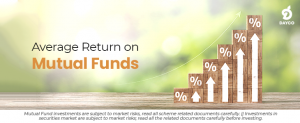What Is the Average Return on Mutual Funds in India
![]() September 23, 2023
September 23, 2023
![]() 0 Comments
0 Comments
We all talk about Mutual funds being “sahi” or correct. But how do you quantify the effectiveness of mutual funds? Of course, by calculating the returns generated by mutual funds in India. So, in this blog post, we will explore the average returns generated by Mutual Funds in India.
However, as you know, there are many different kinds of Mutual Funds - from equity to debt to hybrid. Even equity funds can be further segregated in terms of index funds, multi-cap funds, flexi-cap funds, thematic funds, sectoral funds, etc. In this blog post, we will explore the average returns of these individual KINDS of mutual funds. So, let’s start.
A Brief Refresher: What Is a Mutual Fund and Why Are They Popular
The term Mutual Fund has two words - ‘Mutual’ and ‘Funds’. The words themselves suggest that Mutual Funds are a kind of fund where people invest money in - mutually. This means that a mutual fund comprises a large number of people - not any single individual. This is why when you invest in a Mutual Fund, you get ‘units’ of the fund.
Now the question is, what are mutual funds made of? Every mutual fund invests in a basket of stocks. So, a mutual fund is made of the underlying stocks that it has invested in. For example, a Nifty 50 index fund invests in stocks that are in the Nifty 50 index. Similarly, a large-cap fund invests in a basket of large-cap stocks.
Advantages of Mutual Funds
Mutual Funds are popular for reasons more than one-
- Diversification: Since mutual funds invest in multiple stocks, investing in even just one fund gives you the benefit of diversification. Diversification enables you to dilute the risks associated with investing in just one or two stocks.
- Standing on the shoulders of fund managers: When you invest in mutual funds, it is the fund manager who makes sure that the fund is investing in good stocks. So you can offload the task of researching stocks.
- Long-Term Investing: Investors having a long-term horizon can choose equity mutual funds because it is made exactly for that. If you have at least a 5-year investment horizon, equity mutual funds can be your best friend.
- Strict Regulations: Mutual Funds are regulated by the Securities and Exchange Board of India (SEBI), the capital markets regulator in India, under SEBI (Mutual Funds) Regulations, 1996. There are stringent rules and regulations in place that protect the investor, help them raise their grievances, and keep them well-informed.
Importance of Understanding Mutual Fund Returns
Since mutual funds are market-linked instruments, the returns aren’t available beforehand. Hence, understanding investment performance is vital. Also, it is important that you measure your returns periodically to gauge how well your fund is performing – whether it has outperformed its benchmark or the returns are above the average returns seen in the peer category.
Since mutual funds are subject to volatility, it is important to measure returns in an annualized return as it takes into account the volatility in returns generated over a period of time. There are mainly two kinds of returns you should know when investing in mutual funds– one is CAGR (Compounded Annual Growth Rate), and the other is XIRR (Extended Internal Rate of Return).
CAGR is best for measuring returns when there are no periodic returns in between as these will not be considered by CAGR. XIRR is a more advanced approach that can be used when there are multiple cash flows in a portfolio, like in an SIP or in an equity portfolio.
Average Return Generated by Index Funds in India
Since index funds track the indices, we usually expect that they mirror the returns generated by the respective indices.
Let’s start with Nifty 50 funds. Any Nifty 50 index mutual fund comprises stocks that feature in the Nifty 50 index. The funds also try to replicate the allocation percentage based on the weights given to the individual stocks by Nifty 50. As a result, such funds mirror the ups and downs seen in the Nifty 50 index. The Average Return of an Index Fund mirrors the respective index it tracks. Mostly, the returns are lower than the returns generated by the index due to tracking error– which happens due to portfolio rebalancing charges and the expense ratio of the fund. This is why tracking error and expense ratio should be the main criteria when selecting index funds.
Average Returns Generated By Equity Mutual Funds
The large-cap category of funds have given an average annualized return of 12.5% over the last 5 years. Large cap mutual funds invest in stocks having a large market share. These large-cap companies have a proven track record of generating impressive revenue and profits - both for themselves and the shareholders. The scenario becomes interesting when it comes to mid-cap funds. Most mid-cap funds in India have generated returns between 15% to 18% - CAGR over the last 5 years. When it comes to small-cap funds, it’s a hit or miss. Depending on the fund manager and choice of small-cap stocks, the returns of small-cap funds can vary significantly. However, the average category return has been more than 20% over the last 5 years.
Over to Flexi Cap mutual funds. These funds can invest in stocks having any market capitalization. Unlike multi-cap funds that need a minimum of 25% exposure to large-cap, mid-cap, and small-cap stocks, flexi-cap funds aren’t bogged down by this limitation. The average return in this category has been 13.39% over the last five years.
Average Returns Generated by Debt Mutual Funds and Hybrid Mutual Funds in India
Debt funds are regarded as low-risk, low-return funds. These funds are suitable for risk-averse investors, portfolio diversification, and for meeting short to medium-term goals. As opposed to equity funds, past average return in the debt funds isn’t any meaningful metric. As the funds invest in fixed-income vehicles, the returns depend on the present portfolio of the fund, which can be gauged using the yield to maturity of the fund and the modified duration.
Debt funds can be of many different forms, and depending on their type, the return varies. The most liquid and safest among the debt funds are liquid funds. The common debt fund categories are:
- Ultra Short-Term Fund – Invests in Debt & Money Market instruments with Macaulay duration of the portfolio between 3 months - 6 months
- Money Market Funds – Investment in Money Market instruments having maturity up to 1 Year
- Corporate Bond Fund – Minimum 80% investment in corporate bonds only in AA+ and above rated corporate bonds
- Short Duration Funds: Investment in Debt & Money Market instruments with Macaulay duration of the portfolio between 1 year - 3 years
- Gilt Funds – Minimum 80% investment in government securities across the maturity
When investing in debt funds, it is very important that you match your investment horizon as per the average maturity of the debt fund that you select. The credit profile of the fund is also important. A fund should majorly comprise high-rated debt instruments.
Coming to the hybrid category of mutual funds. This category comprises funds that invest in different asset classes like equity, debt, gold, and other alternative instruments. Multi-asset funds – that invest in at least 3 asset classes with a minimum allocation of at least 10% in each asset class– have given an average return of around 12%. Aggressive hybrid funds - that invest at least 75% of the fund money in stocks and 25% in debt instruments - have given a return of 11% to 14% over the period of 5 years, while conservative hybrid funds - having more exposure to debt instruments and less to stocks - generally give a return of around 7 - 10% over the same period.
Aside from all these, there is another category of funds that are officially known as dynamic asset allocation funds and colloquially known as balanced advantage funds. These funds can invest in a mixture of debt and equity– without any minimum allocation criterion. These funds have generated a return of around 10% to 14% over the last 5 years.
In Summary
As you can see, mutual funds can be a great instrument to build wealth. Remember, Mutual Funds aren’t a get-rich-quick scheme. You have to be patient and make sure that your goals are aligned with the type of fund you choose to invest in. But one thing is sure: no matter the type of goals you have, there will always be an appropriate mutual fund type to choose from.
If you have a question, share it in the comments below or DM us or call us – +91 9051052222. We’ll be happy to answer it.
~ Dimensions, Nischay Avichal
Share With
I'm a cool paragraph that lives inside of an even cooler modal. Wins!
Are you sure?
In case you didnt know, you can open your account online within 24 hours. Offline account opening takes up to 4 working days. If you wish to open your account offline, fill and sign the forms using a black/blue ballpoint pen. Please fill in the email and mobile number of the applicant to avoid account opening delays.
Enter Password
Please enter your details and password
New to Dayco?
Enter Password
Please enter your details and password
New to Dayco?
Filing Complaints on SCORES (SEBI) – Easy & Quick
- Register on SCORES Portal (SEBI)
- Mandatory details for filing complaints on SCORES:
- Name, PAN, Address, Mobile Number, E-mail ID
- Benifits:
- Effective Communication
- Speedy redressal of the grievances
Thanks !!
Your details were successfully received.

Thank you for Your Feedback!
Our Team is working constantly on improving our user experience and your feedback really means a lot.
Thanks !!
App Link Send to your mobile number successfully.
Thank You
All your Questions have been recorded
Thank You
All your Questions have been recorded
Thank You!
Thank you for your response. We'll get in touch with you at the earlisest for your investment planning needs
NEXT
Thank You!
Thank You for your interest in our Moderate Equity Portfolio. Please find below the credentials to track this portfolio:
User ID: mockmod@daycoindia.com
Password: abcd@1234
Portfolio Tracker
Please Read!
Risk profiling is crucial for identifying and managing potential risks in investment decisions. Please carry out your risk profiling before making any investment decisions.
Complete Risk Assessment Now
Thank You !!
Please enter your details to download/print the report
Thank You !!
Please enter your details to download/print the report
Thank You !!
Please enter your details to download/print the report
Thank You !!
Please enter your details to download/print the report
Thank You !!
Please enter your details to download/print the report
Set Your Goal
Please Select an option from below
Set Your Goal
Please Select an option from below
Thanks You !
We appreciate your interest in our services. Our team will be in touch with you shortly.
CloseSet your Goal
Please enter your details in the fields provided
Thanks You!!
Calculation report has been sent to your mail id successfully
Clear form?
This will remove your answers from all questions and cannot be undone.



 Book Appointment
Book Appointment









Leave a Reply